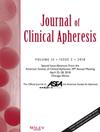Use of a novel configuration of ports for patients needing intermittent long-term apheresis
Abstract
Purpose
In patients with a need for frequent but intermittent apheresis, vascular access can prove challenging. We describe the migration of the use of a Vortex LP dual lumen port (Angiodynamics, Latham, NY) to one Powerflow and one ClearVUE power injectable port (Becton Dickinson, Franklin Lakes, NJ) in a series of patients undergoing intermittent apheresis.
Materials and Methods
All patients had a need for long-term intermittent apheresis. Eight had double lumen Vortex port (pre) and were exchanged for one Powerflow port and one conventional subcutaneous venous port with 90° needle entry (post) while 12 did not have any port in place and received the same configuration. IRB approval was granted. We recorded the treatment time, flow rate, and tissue plasminogen activator (tPA) use for five treatment sessions after placement. When available, we compared five treatments with the Vortex port and the new configuration.
Results
The mean treatment time is reduced with the new configuration (P = 0.0033). The predicted mean treatment time, adjusting for gender, race, BMI and age and accounting for correlations within a patient is 91.18 min pre and 77.96 min post. The flow rate is higher with the new configuration (P < 0.0001). The predicted mean flow rate in mL/min is 61.59 for the Vortex port and 71.89 for the new configuration. tPA use was eliminated in the population converted from Vortex ports and had a 48% reduction when compared to all other configurations in the study.
Conclusion
The introduction of a novel device configuration of venous access ports for intermittent apheresis resulted in higher flow rates and less total time for treatment. Use of tPA was greatly reduced. These results suggest that the new configuration could result in less expense for the hospital and better throughput in a busy pheresis practice.
Clinical trial registration with ClinicalTrials.gov: NCT04846374.

 求助内容:
求助内容: 应助结果提醒方式:
应助结果提醒方式:


